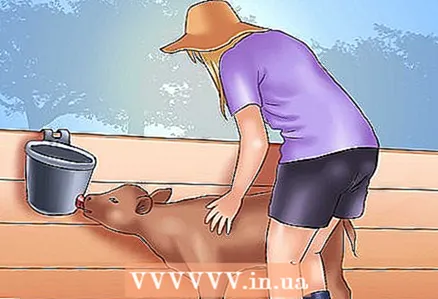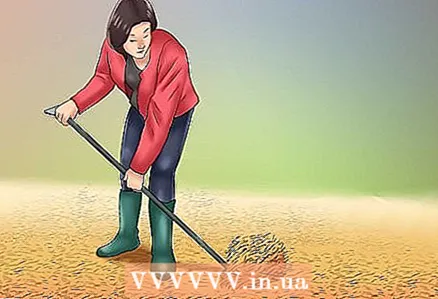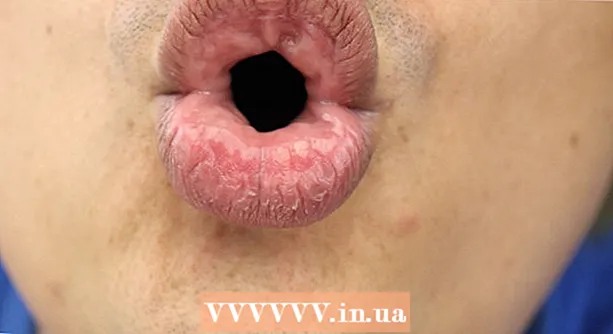Author:
Gregory Harris
Date Of Creation:
12 August 2021
Update Date:
22 June 2024

Content
If you are raising livestock, the time will surely come when you have to take care of an orphaned calf. You will need to take on the responsibilities of a mother when his biological mother abandons her child. If all attempts to get the cow to accept the calf have failed, then you need to take care of him.
Steps
 1 Place the calf in a warm, safe and quiet area. Any place where the calf can shelter from the weather and other animals will do. It would also be nice to get (buy or make) a cage. It must be strong enough in case the calf decides to run away.
1 Place the calf in a warm, safe and quiet area. Any place where the calf can shelter from the weather and other animals will do. It would also be nice to get (buy or make) a cage. It must be strong enough in case the calf decides to run away. - Make sure you cover the floor with straw that it will sleep on (especially important if it appears in winter or early spring). You can't just leave the calf in the barn without any bedding. It is more susceptible to chills than adult cows and a thick layer of hay will help keep it warm.
- If the calf was born in the summer, then it will need an area where it can hide from the sun. However, you should not deprive him of access to the sun. Calves need vitamin D and sometimes like to sleep in the sun.
 2 Buy the food you need and get the proper medical attention as soon as possible. Colostrum should be a priority and always at hand. Colostrum powder can be purchased at a pet food store or from your veterinarian.
2 Buy the food you need and get the proper medical attention as soon as possible. Colostrum should be a priority and always at hand. Colostrum powder can be purchased at a pet food store or from your veterinarian. - You must feed the calf with colostrum for the first 72 hours of its life. During this period, he is most vulnerable to various diseases, including fatal ones.
- Colostrum should be given every 2-3 hours. Depending on the weight, the feeding volume varies from 1 to 2 liters per feeding. If the calf refuses to drink from the bottle, use a stomach tube for feeding (especially if the calf is weak from cold or difficult labor). It is imperative to give colostrum in the first 15 minutes of life.
- If the calf is hungry, it will immediately accept the bottle, especially if you sprinkle milk on its lips to taste it. Young calves that have not sucked milk from the udder accept the bottle very easily. However, if the calf has already sucked milk from the udder, then it will be difficult to accustom him to the bottle.
- Colostrum should be given every 2-3 hours. Depending on the weight, the feeding volume varies from 1 to 2 liters per feeding. If the calf refuses to drink from the bottle, use a stomach tube for feeding (especially if the calf is weak from cold or difficult labor). It is imperative to give colostrum in the first 15 minutes of life.
- You must feed the calf with colostrum for the first 72 hours of its life. During this period, he is most vulnerable to various diseases, including fatal ones.
 3 Feed the calf with a bottle or bucket every 2-3 hours until a few days old. During this period, you can gradually replace colostrum with milk. After the change, you can feed the calf 3 times a day: morning, afternoon and evening. Make sure you are giving milk equal to 10% of the calf's weight per day.
3 Feed the calf with a bottle or bucket every 2-3 hours until a few days old. During this period, you can gradually replace colostrum with milk. After the change, you can feed the calf 3 times a day: morning, afternoon and evening. Make sure you are giving milk equal to 10% of the calf's weight per day. - As the calf gets older, the number of feeds per day decreases. When he is a month old, it is necessary to feed 2 times a day, and when he is more than 2 months old - once. The calf is removed from the bottle when it is 3-4 months old.
 4 The calf should always have fresh water. The bucket must be stable so that the calf does not overturn it. They are very curious and will soon find out that the clear liquid in the bucket is essential for drinking.
4 The calf should always have fresh water. The bucket must be stable so that the calf does not overturn it. They are very curious and will soon find out that the clear liquid in the bucket is essential for drinking.  5 Feed your calf only high quality feed. Special feed for young calves can be purchased at a feed store. These foods will help the calf grow healthy. They contain protein, calcium, phosphorus, and other important nutrients for growth.
5 Feed your calf only high quality feed. Special feed for young calves can be purchased at a feed store. These foods will help the calf grow healthy. They contain protein, calcium, phosphorus, and other important nutrients for growth. - The calf also needs high quality hay. Check the hay. Very often, the good on the outside is terrible on the inside. It should be 60% legumes (alfalfa or clover) and 40% grass.
 6 Talk to your veterinarian about what vaccines and vitamin / mineral injections your calf needs. It depends on age, health status and place of residence. Injections include vitamins A, D, E, etc.
6 Talk to your veterinarian about what vaccines and vitamin / mineral injections your calf needs. It depends on age, health status and place of residence. Injections include vitamins A, D, E, etc. - Vaccinations will also be necessary if you have not vaccinated the cows or if you have not fed the calf colostrum from its mother. Some vaccinations are injected when the calf is 2-3 months old.
 7 Keep the area where the calf lives clean. Change the dirty straw every day and use a pitchfork and shovel to remove feces and dirty straw. Also check where the calf is eating. Replace food if necessary ..
7 Keep the area where the calf lives clean. Change the dirty straw every day and use a pitchfork and shovel to remove feces and dirty straw. Also check where the calf is eating. Replace food if necessary ..  8 Examine the calf for disease. If the calf has diarrhea, infectious diseases, breathing problems, etc., call your veterinarian right away.
8 Examine the calf for disease. If the calf has diarrhea, infectious diseases, breathing problems, etc., call your veterinarian right away. - Many people are too worried about coughing. Sometimes a cough or sneeze is caused by dust or food particles. If coughs and sneezes are not regular, then there is nothing to worry about. If the cough is persistent and other symptoms appear, call your veterinarian.
- Eating irregularly can cause stomach upset and other related illnesses. Maintain your diet.
- Check the calf for fleas, ticks, lice, and other parasites that can spread disease. A mosquito and fly spray will make his life easier.
 9 Watch the diet, take care and take care of the calf and soon it will begin to grow, and then completely turn into an adult animal!
9 Watch the diet, take care and take care of the calf and soon it will begin to grow, and then completely turn into an adult animal!
Tips
- Establish a written feeding, care and health schedule. This step ensures that you don't get out of rhythm or forget anything.
- Raising the calf outdoors (summer, early spring or early fall) is the best way. It is best to provide it with a company of other pets (goats, for example). He will be able to learn from them to lick salt, drink, graze and hide from the weather.
- Always keep colostrum handy. You don't know when you might need it.
- Provide pasture for the calf if possible. Some calves may start eating grass when they are just a few days old.
- Milk should be given equal to 10% of the calf's body weight per day. Divide this amount into 2-3 servings.
- A halter is a great way to keep a calf chained to a specific area.
Warnings
- Calves are strong creatures. Make sure you handle him so he won't kick or butt you.
- Dairy calves are the most susceptible to diseases and more often die from them, in contrast to meat calves. Take extra care when feeding them with a bottle.
- Don't make your bulls into pets. Such bulls can grow into very dangerous animals that have no respect for humans. To prevent this, do not become attached to the bull or castrate it as soon as possible.



